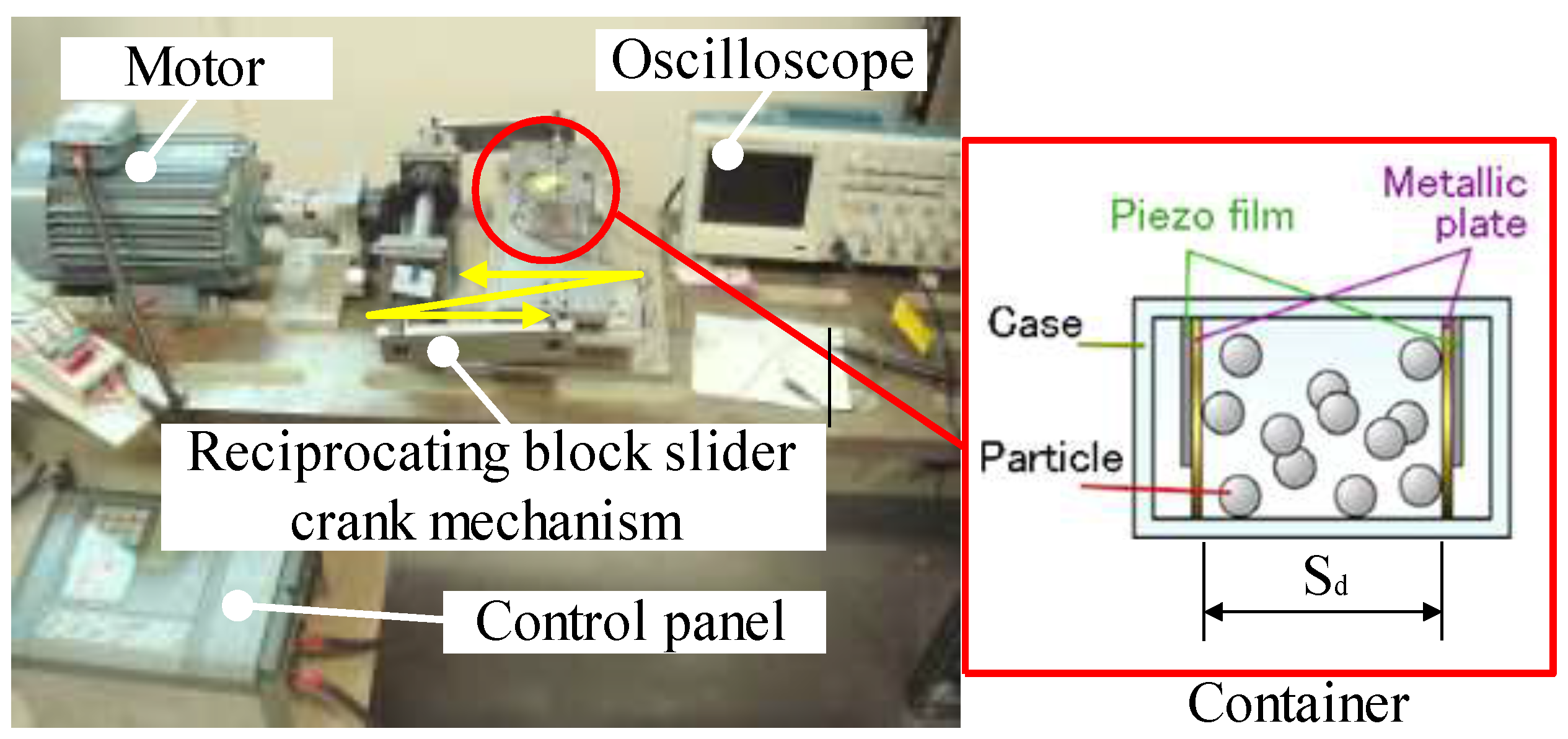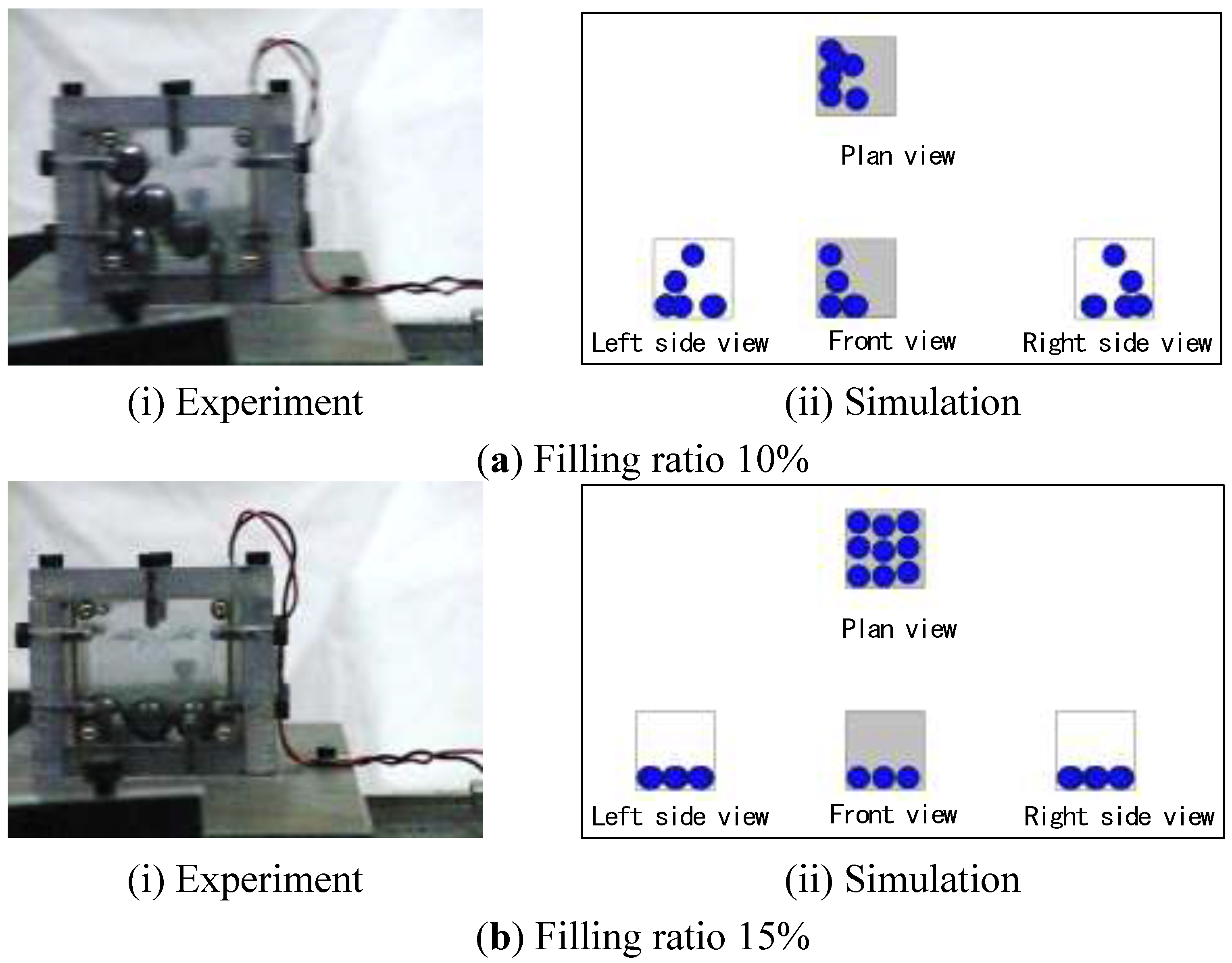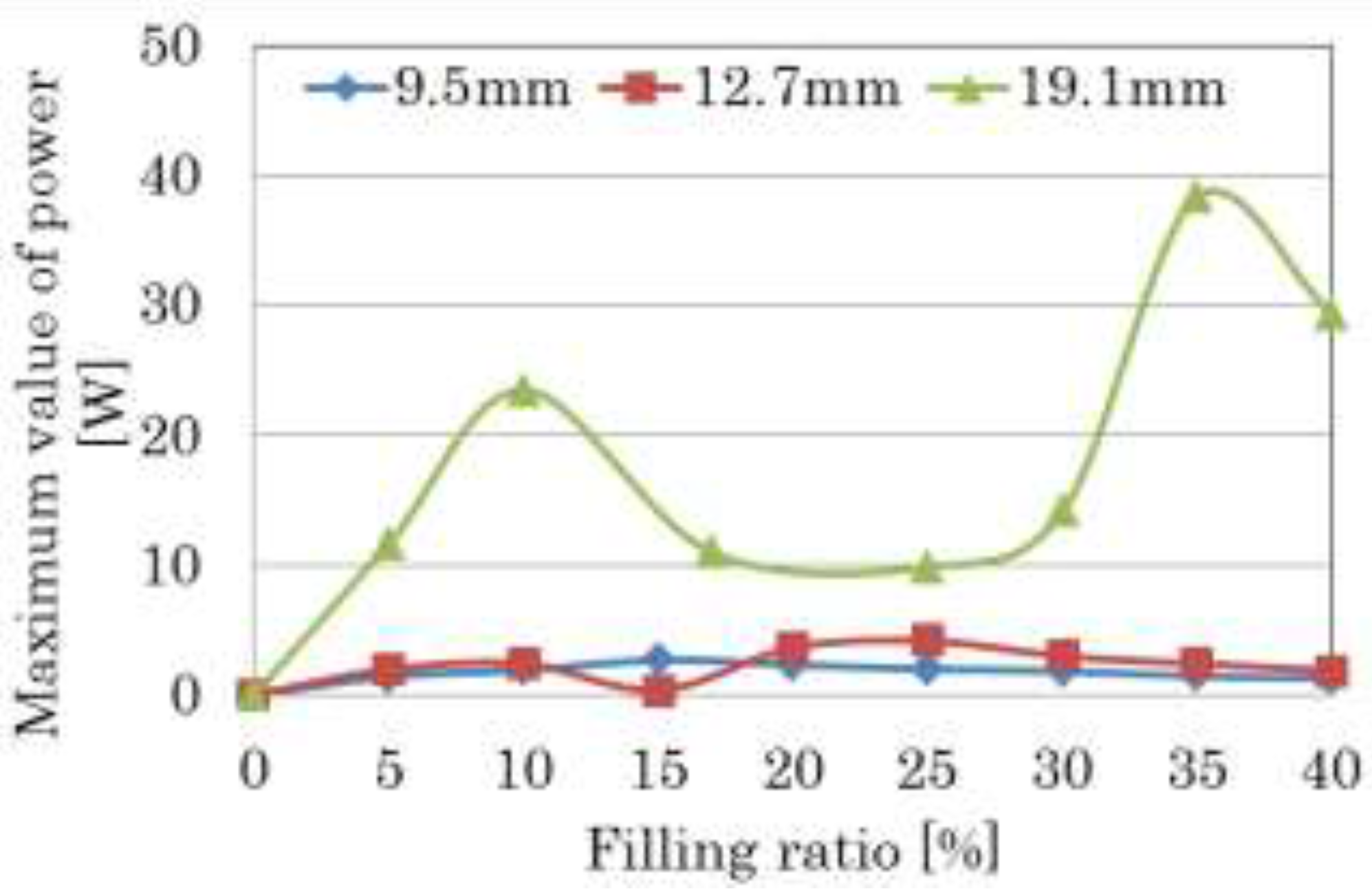Examination of Particle Behavior in Container on Multi-Particle Collision Damper
Abstract
:1. Introduction
2. Calculation Method
Equations of Motion for Particles


| Material | Particle | Container |
|---|---|---|
| Carbon Steel | Acrylic | |
| Density (kg/m3) | 7873 | - |
| Young’s modulus (MPa) | 2.07 × 105 | 4.90 × 103 |
| Poisson’s ratio | 0.26 | 0.32 |
3. Experimental Apparatus

4. Results of Experiments and Results of Calculations
4.1. Particle Behavior

4.2. Effect of Input Amplitude of Container

4.3. Effect of Frequency of Container



4.4. Effect of Particle Size


5. Conclusions
- (1)
- Effective collision occurs depending on the combination of particle size and filling ratio. The frequency of particles colliding with the side wall of the container is higher than the reciprocating frequency of the container.
- (2)
- When the flow condition of the particles is the jumping motion, the particle brings about the effect to the side wall. Inversely, when balanced, the effect is small.
- (3)
- A simple system using a piezoelectric element is an effective method to obtain the effects of particle collisions.
- (4)
- The behavior of particles and flow conditions using DEM simulations agreed well with experimental results. It is possible to evaluate the effect of particle collisions using DEM.
Author Contributions
Conflicts of Interest
References
- Nagashima, T.; Sato, T.; Tanaka, K. Vibration Control Using an Impact Damper System—Comparison between Translating Impactor and Rotating Impactor, and Improvement of Rotating Impactor. J. Environ. Eng. 2010, 5, 402–416. [Google Scholar] [CrossRef]
- Duncan, M.R.; Wassgren, C.R. The damping performance of a single particle impact damper. J. Sound Vib. 2005, 286, 123–144. [Google Scholar] [CrossRef]
- Friend, R.D.; Kinra, V.K.; Krousgrill, C.M. Particle impact damping. J. Sound Vib. 2000, 233, 93–118. [Google Scholar] [CrossRef]
- Inoue, M.; Yokomichi, I.; Hiraki, K. Particle damping with granular materials for multi degree of freedom system. Shock Vib. 2011, 18, 245–256. [Google Scholar] [CrossRef]
- Araki, Y.; Yokomichi, I.; Inoue, J. Impact Damper with Granular Materials 2nd Report, Both Sides Impact in a Vertical Oscillating System. Bull. JSME 1985, 28, 1466–1472. [Google Scholar] [CrossRef]
- Lu, Z.; Lu, X.; Masri, S.F. Studies of the performance of particle dampers under dynamic loads. J. Sound Vib. 2010, 329, 5415–5433. [Google Scholar] [CrossRef]
- Saeki, M. Impact Damping with Granular Materials in a Horizontally Vibrating system. J. Sound Vib. 2002, 251, 153–161. [Google Scholar] [CrossRef]
- Saeki, M. Analytical study of multi-particle damping. J. Sound Vib. 2005, 281, 1133–1144. [Google Scholar] [CrossRef]
- Sánchez, M.; Carlevaro, C.M. Nonlinear dynamic analysis of an optimal particle damper. J. Sound Vib. 2013, 332, 2070–2080. [Google Scholar] [CrossRef]
- Cundall, P.A.; Strack, O.D.L. A Discrete Numeric Model for Granular Assemblies. Geotechnique 1979, 29, 47–65. [Google Scholar] [CrossRef]
- Cleary, P.W.; Sawley, M.L. DEM modelling of industrial granular flows: 3D case studies and the effect of particle shape on hopper discharge. Appl. Math. Model. 2002, 26, 89–111. [Google Scholar] [CrossRef]
- Balevičius, R.; Kačianauskas, R.; Mróz, Z.; Sielamowicz, I. Analysis and DEM simulation of granular material flow patterns in hopper models of different shapes. Adv. Powder Technol. 2011, 22, 226–235. [Google Scholar] [CrossRef]
- Mishra, B.K.; Rajamani, R.K. Motion Analysis in Tumbling Mills by the Discrete Element Method. Kona 1990, 8, 92–98. [Google Scholar] [CrossRef]
- Yamane, K.; Sato, T.; Tanaka, T.; Tsuji, Y. Computer Simulation of Tablet Motion in Coating Drum. Pharm. Res. 1995, 12, 1264–1268. [Google Scholar] [CrossRef] [PubMed]
- Paul, W. Cleary, Predicting Charge Motion, Power Draw, Segregation and Wear in Ball Mills Using Discrete Element Methods. Miner. Eng. 1998, 11, 1061–1080. [Google Scholar]
- Kano, J.; Chujo, N.; Saito, F. A Method for Simulating the Three-Dimensional Motion of Balls under the Presence of a Powder Sample in a Tumbling Ball Mill. Adv. Powder Technol. 1997, 8, 39–51. [Google Scholar] [CrossRef]
- Tsuji, Y.; Ishida, T.; Tanaka, T. Lagrangian Numerical Simulation of Plug Flow of Cohesionless Particles in a Horizontal Pipe. Powder Technol. 1992, 71, 239–250. [Google Scholar] [CrossRef]
- Kawamoto, Y.; Kataoka, M.; Uekusa, M.; Terumichi, Y. Behavior of Two Kinds of Particles in Rotary Barrel with Planetary Rotation. Multibody Syst. Dyn. 2004, 12, 187–207. [Google Scholar] [CrossRef]
- Takahashi, Y.; Kataoka, M.; Uekusa, M.; Terumichi, Y. Behavior of Three Kinds of Particles in Rotary Barrel with Planetary Rotation. Multibody Syst. Dyn. 2005, 13, 195–209. [Google Scholar] [CrossRef]
- Timoshenko, S.; Goodier, J.N. Theory of Elasticity, 2nd ed.; Mcgraw-Hill Kōgakusya: Tokyo, Japan, 1951; pp. 372–384. [Google Scholar]
© 2015 by the authors; licensee MDPI, Basel, Switzerland. This article is an open access article distributed under the terms and conditions of the Creative Commons Attribution license (http://creativecommons.org/licenses/by/4.0/).
Share and Cite
Takahashi, Y.; Sekine, M. Examination of Particle Behavior in Container on Multi-Particle Collision Damper. Machines 2015, 3, 242-255. https://doi.org/10.3390/machines3030242
Takahashi Y, Sekine M. Examination of Particle Behavior in Container on Multi-Particle Collision Damper. Machines. 2015; 3(3):242-255. https://doi.org/10.3390/machines3030242
Chicago/Turabian StyleTakahashi, Yoshihiro, and Mika Sekine. 2015. "Examination of Particle Behavior in Container on Multi-Particle Collision Damper" Machines 3, no. 3: 242-255. https://doi.org/10.3390/machines3030242





